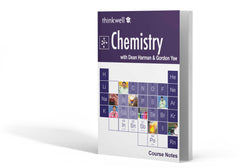
Honors Chemistry (College Level)
$199.00
Thinkwell's Honors Chemistry
Thinkwell's Honors Chemistry is adapted from a two-semester college-level course. It's intended for successful college-bound students, especially ones interested in pursuing science. The course is taught by top professors from prestigious universities. Thinkwell's Chemistry has similar content to leading chemistry textbooks and the instructional videos are ideal for households where parents are not scientists!
If you're preparing for the Chemistry AP® test, check out Thinkwell's Chemistry compatible with AP®, which includes diagnostic assessments geared towards AP® exam preparation. What's the difference between Honors and AP Chem? Check out a comparison of the courses here.
The Printed Notes (optional) are the Honors Chemistry course notes from the Online Subscription printed in color, on-the-go format.
Prerequisites: High School Chemistry and Algebra 2







